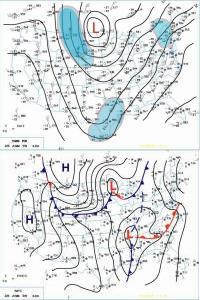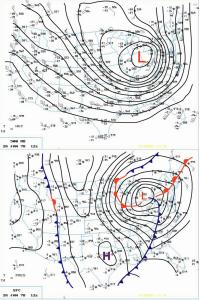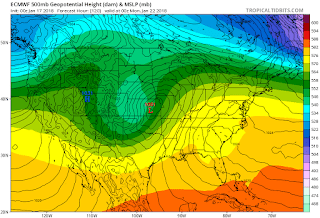"A GREAT STORM IS UPON MICHIGAN"
THE GREAT BLIZZARD OF 1978!
Written by: William R. Deedler, Weather Historian - Southeast Lower MI
While I worked countless snowstorms in my long career with the NWS; the two most impressive storms were in order: the January 26-27, 1978 Blizzard and the December 1st, 1974 snowstorm. The huge snowstorm of December 1974 was quite noteworthy in the amount of snow that fell continuously for hours over the Detroit Metro area and portions of Southeast Lower Michigan.
A more powerful (in terms of intensity/extent) storm and remains of strong interest to all meteorologists who have studied winter storms in the Great Lakes is the January 1978 Blizzard. This storm is also of interest and remembrance to many longtime residents of the Great Lakes, the Upper Ohio Valley and Ontario, Canada who had to deal with winter's full fury late in January of 1978. In addition, the storm certainly casts many memories for those of us (author included) who were on duty and worked during the storm while observing in tremendous awe the development and subsequent immense strength of this great monster. With the 40th anniversary of this Great Blizzard at hand, it is worth taking a step back in time to re-live this monumental example of nature's fury.
While there are several contenders for the worst blizzard ever to hit
the Great Lakes in relatively modern times (since 1870 when records
began in Detroit), the immense and intense Blizzard of January 26-27th
1978 must rank at or near the top along with the Great White Hurricane of 1913 with its similar track and powerfulness.
The incredible Blizzard of January 26-27th, 1978 evolved out of a
winter that was infamous for cold and storms. The Winter of 1977-78 thus
far had been one the coldest, since records began, in many areas from
the Rockies eastward to the Appalachians. Mammoth blizzards occurred
late in January and early February from the Midwest to the East Coast as
strong Arctic plunges dove south into the country and met up with the
warmer winds from the deep south. The winter of 1977-78 was similar to
its predecessor (1976-77) in terms of cold. The main difference between
the two winters, however, came in February. In 1977, temperatures
moderated rapidly during February, while in 1978, the cold actually
worsened - with several locations reporting their coldest recorded
February to date. The Winter of 1977-78 is written down in the record
books as Detroit's seventh coldest winter, Flint's fifth coldest and
Saginaw's sixth. West of the Rockies, it was a different story as a
dominant upper ridge of high pressure provided a relatively mild winter,
with some stations even reporting one of their warmest winters on
record.
The Great Storm
The Great Storm
Since there were some forecasting variances of the intensity and track
of the storm, and considering the primitive model of the day (LFM -
Limited Fine Mesh), forecasters did an admirable job in forecasting one
of the most severe winter storms ever to hit the Great Lakes Region.
A Winter Storm Watch was posted as early as Tuesday night, the 24th,
for the southern half of the Lower Peninsula for Wednesday Night into
Thursday. Gale Warnings for the Great Lakes were hoisted the following
Wednesday morning, along with the Watch. A weaker system had moved
through the region earlier during the day on Tuesday and already dropped
some snow on the region (a Winter Storm Watch had been issued for this
system as well, earlier on Monday, the 23rd). After Tuesday's snow, the
headline on the Special Weather Statement that was issued by the NWS
Tuesday evening read as follows: "Another Winter Storm Threatens Lower
Michigan" and thus, a second Winter Storm Watch was officially posted.
Meanwhile, the ingredients of what would later prove to be a truly
fascinating yet vicious winter storm were coming together from different
parts of the country. As with the "White Hurricane of 1913," the
massive storm actually began as two smaller but distinct storms. A
strong low pressure with an attending arctic air mass was entering the
Northern Plains by way of Northern Minnesota on Tuesday evening (24th).
At the same time, another developing low pressure system was taking
shape over the eastern Texas/Louisiana area.
 The phasing of two distinct jet streams aloft proved to be the key as
to the subsequent strength and massive extent of the storm. A very
strong and energetic Arctic impulse surged almost due south and plowed
the Arctic front through the Northern Plains late on the 24th. At the
same time, another very strong upper wind impulse surged south through
southern Arizona. These two jet streaks made up the larger North
American jet stream as a huge upper ridge of high pressure along the
West Coast of the U.S. diverted the powerful Pacific Jet north into
Northern Canada. This northern jet (containing a wind max of 110 knots)
then dove due south, like on a giant roller coaster, across the western
U.S. as the second, subtropical jet (with an even stronger wind max of
130 knots) surged across southwestern states. On Wednesday (25th), a
deepening area of low pressure made its way east across the Gulf States
into Georgia by evening (surface | 500mb).
Meanwhile, across the north, the Arctic front barreled east across the
Upper Midwest into the Western Lakes by Wednesday evening.
The phasing of two distinct jet streams aloft proved to be the key as
to the subsequent strength and massive extent of the storm. A very
strong and energetic Arctic impulse surged almost due south and plowed
the Arctic front through the Northern Plains late on the 24th. At the
same time, another very strong upper wind impulse surged south through
southern Arizona. These two jet streaks made up the larger North
American jet stream as a huge upper ridge of high pressure along the
West Coast of the U.S. diverted the powerful Pacific Jet north into
Northern Canada. This northern jet (containing a wind max of 110 knots)
then dove due south, like on a giant roller coaster, across the western
U.S. as the second, subtropical jet (with an even stronger wind max of
130 knots) surged across southwestern states. On Wednesday (25th), a
deepening area of low pressure made its way east across the Gulf States
into Georgia by evening (surface | 500mb).
Meanwhile, across the north, the Arctic front barreled east across the
Upper Midwest into the Western Lakes by Wednesday evening.
Earlier that Wednesday morning, the Winter Storm Watch for Southeast
Lower Michigan was changed to a Heavy Snow Warning, while a Travelers
Advisory was issued for Western and Northern Lower Peninsula. Later, at
the issuance of the evening forecast, the entire Lower Peninsula was
upgraded to a Heavy Snow Warning. Meanwhile, a rapid deepening of the
surface low over the southeast portion of the country also commenced on
Wednesday evening. As the low intensified over Alabama and Georgia,
Atlanta registered its lowest barometric pressure ever late on the 25th.
At the same time, further north in Michigan, snow was falling over much
of the Lower Peninsula. In and around the Ann Arbor and Metro Detroit,
the snow mixed with or changed to light rain Wednesday night as slightly
warmer air surged northwest
into that area ahead of the deepening storm.
While the storm was
organizing in the lower levels of the atmosphere over Georgia, the
Subtropical and Arctic jet aloft began to merge and phase over the
Southeast part of the country. This merging of jet streaks
contained a wind max of 150 knots which helped induce a rapid
intensification of the Georgia Low as it surged northward into West
Virginia early on the 26th. Record low barometric pressures were set all
along its path as an ominous track (trough) began to materialize toward
the Eastern Great Lakes.
Bands of heavier snow spread north into much of Southern Lower
Michigan during the very early morning hours of the 26th. Rain continued
to fall, however, over the extreme southeast corner of Lower Michigan.
At 1 AM EST, rain was observed at Detroit Metro Airport with the
temperature comfortably above freezing at 36 degrees. Further north at
Flint, however, sleet and freezing rain were falling as the temperature
hovered around freezing. Air pressure tendencies were noted as falling
rapidly /PRESFR/ and continued that way for several hours (in fact,
several stations in this storms path had to re-adjust their barographs
for station pressures traces that were BELOW initial chart scale).
The aforementioned Arctic cold front that was across the Western
Great Lakes advanced steadily east into Lower Michigan as the main
southern low underwent explosive deepening (this low's central pressure
fell 40 millibars in 24 hours)! The central pressure was recorded at
28.28 inches as it tracked north across eastern Ohio, just west of
Cleveland, at 7AM EST. As the low moved out over Lake Erie, the Arctic
cold front over Southeast Lower Michigan was pulled sharply east into
it's mammoth cyclonic circulation. Any residual rain over Southeast
Lower Michigan quickly changed to heavy snow and blowing snow during the
pre-dawn hours of the 26th. As the Arctic front plowed through the
Cleveland area, the wind gusted to an incredible 82 mph! As the Arctic
air flooded the Cleveland area, the temperature dropped from a
relatively balmy 44 degrees at 4AM EST to a bitterly cold 7 degrees by
1000 AM EST.

Blizzard Warnings were hoisted across much of the Great Lakes and Upper
Ohio Valley Region by daybreak Thursday. The center of the huge storm (surface | 500mb)
continued to trek north northwest across Southwest Ontario (roughly
between Chatham and London) while Detroit measured its lowest pressure
reading at 28.34 inches at 650 AM EST. The incredibly deep center made
its way north along the St. Clair River with Sarnia ON reporting the
lowest pressure on land at 28.21 inches. Not only was the depth of this
mammoth storm's center very impressive, so too was the extent of low
pressure from its center. Even locations that were far removed from the
storm's center also reported record low pressures. Stations such as
Cincinnati OH, Rochester NY and Toronto ON and even as far east as
Wilmington N.C., all recorded record low pressure readings from this
monster. In fact, at Toronto, where records go back as far back as 1840,
the lowest pressure reading of 28.40 inches broke the old record of
28.57 inches by 0.17 inches. In addition, dozens of other cities, with
records going back a century, also recorded their lowest pressure
reading of all time or, for at least the month of January. This
massively intense storm was responsible for strong wind gusts as far
away from the center as Boston /72 MPH/ and Chesapeake Bay Bridge /90
MPH/ with even damaging winds reported as far south as Tallahassee FL.
As the Arctic air circulated throughout the storm while it made its
way over Lake Huron, the lowest pressure was reached around 950
millibars or a hurricane-like 28.05 inches! "A Great Storm is Upon
Michigan" read the headline of the 800 AM EST Special Weather Statement
issued by the National Weather Service Forecast Office in Ann Arbor that
Thursday /26th/ morning. Heavy snow and blizzard conditions were
extensive as wind gusts in excess of 35 mph whipped the snow into huge
drifts across much of Southeast Lower Michigan. Other areas of Eastern
Michigan, Indiana and Ohio reported near hurricane-force winds, heavy
snow and temperatures hovering between zero and 10 above, resulting in
extreme blizzard conditions. These conditions later expanded further
east into Pennsylvania and West Virginia and prevailed into the night
(26-27th) across much of the Eastern Great Lakes, Southern Ontario and
the Upper Ohio Valley. With the storm generating copious amounts of snow
and very strong winds, whiteout conditions were widespread. All land
and air traffic came to a stand still in the affected regions. Several
major roads were closed for at least two to three days, if not longer,
while clean up got underway. Numerous NWS employees were stranded at
work, home, or on the road somewhere between the two. Several employees
worked double shifts into at least Friday (some longer) because of the
impassable roads with others simply unable to get to work.
The Blizzard Warnings were allowed to die across Michigan during the
forenoon hours of Friday, the 27th. Record 24 hour snowfall totals from
the storm included, 16.1 inches at Grand Rapids, 15.4 inches at Houghton
Lake and 12.2 at Dayton, OH. Snowfalls for the entire storm (25-27th)
included a whopping 30.0 inches at Muskegon (some of which was Lake
Michigan enhanced), 19.3 inches at Lansing and 19.2 at Grand Rapids.
Snowfalls were less over Southeast Lower Michigan (mainly because of the
rain that fell for a period) and included 9.9 inches at Flint and 8.2
inches at Detroit.
The following is a quote from the summary written about the storm by
Meteorologist in Charge, C.R. Snider on January 30th, 1978 at the
National Weather Service Ann Arbor:
"The most extensive and very nearly the most severe blizzard in Michigan history raged throughout Thursday January 26, 1978 and into part of Friday January 27. About 20 people died as a direct or indirect result of the storm, most due to heart attacks or traffic accidents. At least one person died of exposure in a stranded automobile. Many were hospitalized for exposure, mostly from homes that lost power and heat. About 100,000 cars were abandoned on Michigan highways, most of them in the southeast part of the state."
The employees of the National Weather Service Forecast Office in Ann
Arbor had just set up shop at the new quarters at the Ann Arbor Federal
Building a WEEK before the storm hit. The forecast staff had transferred
from the Detroit Metropolitan Airport Office while the observing and
radar staff remained at the airport. The majority of employees still
lived in and around the metro Detroit area and all major roads between
Detroit and Ann Arbor were blocked for approximately 18 hours due to the
storm. Several employees put forth efforts beyond the call of duty,
stated Mr. Snider in his storm report.
Yet, as mentioned earlier, the Winter was not yet over by any means
as the month of February (after the storm) was brutally cold across much
of country. The below normal temperature departures of February 1978
were strikingly similar to that of January 1978 (and in some places,
February was actually colder). The average temperature for Detroit that
winter came in at just 20.5 degrees /normal 27.1/ which again, made it
the seventh coldest winter on record. Snowfall totaled a hefty 61.7
inches which made the winter of 1977-78 the ninth snowiest winter on
record at Detroit. Flint's average temperature of 19.1 degrees made it
the fifth coldest winter on record, but Flint received less snow than
Detroit with 50.6 inches. Saginaw's winter average temperature of 17.9
degrees made it the sixth coldest winter on record and was accompanied
by 55.6 inches of snow. The 1977-78 snow season at both Flint and
Saginaw has since dropped off the top 20 snowiest winters list.
More on the storm in surrounding areas can be found here.
https://www.ncdc.noaa.gov/news/using-regional-snowfall-index-evaluate-great-blizzard-1978
More on the storm in surrounding areas can be found here.
https://www.ncdc.noaa.gov/news/using-regional-snowfall-index-evaluate-great-blizzard-1978
https://www.youtube.com/watch?v=YuAMWRtT4NY
http://nbc4i.com/2017/01/25/remembering-the-blizzard-of-1978/
Making weather fun while we all learn,
Bill Deedler -SEMI_WeatherHistorian

















